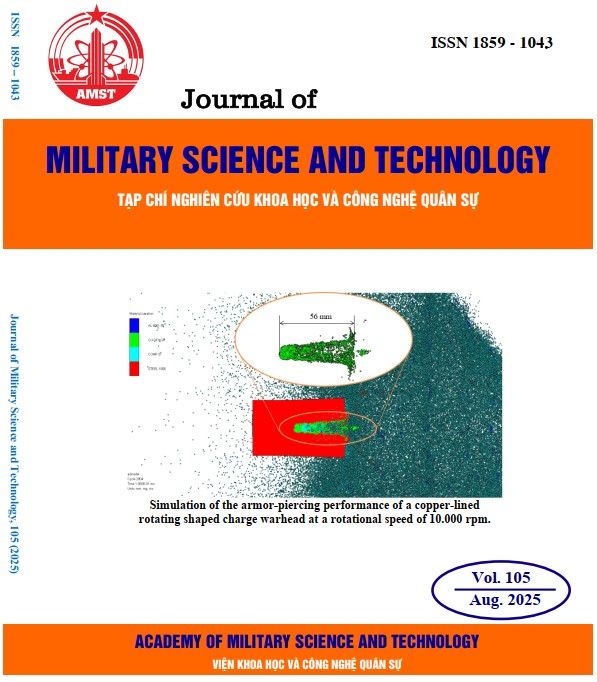Designing an ECG signal measurement and analysis system using SVM algorithm for arrhythmia classification
303 viewsDOI:
https://doi.org/10.54939/1859-1043.j.mst.105.2025.36-43Keywords:
Machine learning; Support Vector Machine (SVM); Hermite basis functions; Electrocardiogram (ECG) signals.Abstract
This paper introduces a hardware device designed for measuring electrocardiogram (ECG) signals, integrated with a remote system for automated signal analysis, facilitating health monitoring and heart disease diagnosis by doctors. The device transmits ECG signals in real-time to a server equipped with software for analyzing and classifying ECG signals using the Support Vector Machine (SVM) algorithm. Hermite basis functions are employed to generate feature vectors. The proposed solution has been validated using ECG signals from the MIT-BIH (Massachusetts Institute of Technology, Boston’s Beth Israel Hospital) database, achieving a 5.07% error rate in classifying seven types of heart rhythms. The SVM algorithm demonstrates high speed and suitability for server-based data classification needs.
References
[1]. P.S. Hamilton and W.J. Tompkins, "Quantitative investigation of QRS detection rules using the MIT/BIH arrhythmia database", IEEE Trans. Biomed Eng., vol. BME-33, pp. 1157-1165, (1986). DOI: https://doi.org/10.1109/TBME.1986.325695
[2]. Thakor, N. V., Webster, J. G., and Tompkins, W. J, “Optimal QRS detector”. Medical and Biological Engineering, 343–50, (1983). DOI: https://doi.org/10.1007/BF02478504
[3]. R. Mark Moody, “The impact of the MIT-BIH Arrhythmia Database”, IEEE Eng. in Medicine and Biology 20(3): 45–50, (2001). DOI: https://doi.org/10.1109/51.932724
[4]. Jalal A. Nasiri, M. Naghibzadeh, “ECG Arrhythmia Classification with Support Vector Machines and Genetic Algorithm”, Third UKSim European Symposium on Computer Modeling and Simulation, (2009). DOI: https://doi.org/10.1109/EMS.2009.39
[5]. Pengfei Gao; Jingwei Zhao; Guijin Wang; Hengkai Guo, “Real time ECG characteristic point detection with randomly selected signal pair difference (RSSPD) feature and random forest classifier”, 38th Annual International Conference of the IEEE Engineering in Medicine and Biology Society (EMBC), pp. 732 - 735, (2016). DOI: https://doi.org/10.1109/EMBC.2016.7590806
[6]. Tran Hoai Linh, Pham Van Nam, “Multiple neural network integration using a binary decision tree to improve the ECG signal recognition accuracy”, International Journal of Applied Mathematics and Computer Science, vol. 24(3), pp. 647–655, (2015). DOI: https://doi.org/10.2478/amcs-2014-0047
[7]. Tran Hoai Linh, Pham Van Nam, Nguyen Duc Thao, "A hardware implementation of intelligent ECG classifier", COMPEL: The International Journal for Computation and Mathematics in Electrical and Electronic Engineering, vol. 34, Iss: 3, pp. 905 – 919, (2015). DOI: https://doi.org/10.1108/COMPEL-05-2014-0119
[8]. Patel, R., Garcia, S., Lee, C. "An IoT-based ECG Monitoring System with Real-Time QRS Detection and Alerting". Journal of Medical Engineering & Technology, (2020).
[9]. Pham, V. N., & Tran, H. L. “Electrocardiogram (ECG) circuit design and using the random forest to ECG arrhythmia classification”. In International Conference on Engineering Research and Applications (pp. 477-494). Cham: Springer International Publishing, (2022). DOI: https://doi.org/10.1007/978-3-031-22200-9_54
[10]. Nguyen Thanh Trung, Vuong Tri Tiep, Phạm Van Nam, “Application of ARM IC and ADAS1000-3 for Designing a Cardiac Electrical Measurement Device with QRS Complex Detection Function”, The International Conference and Exhibition on Control and Automation, 7th Edition -VCCA, (2024).
[11]. Alamatsaz, N., Tabatabaei, L. S., Yazdchi, M., Payan, H., Alamatsaz, N., & Nasimi, F. “A lightweight hybrid CNN-LSTM model for ECG-based arrhythmia detection”, (2022). arXiv.org. https://arxiv.org/abs/2209.00988
[12]. Roy, M. Majumder, S., Halder, A., & Biswas, U. “ECG-NET: A deep LSTM autoencoder for detecting anomalous ECG”. Engineering Applications of Artificial Intelligence, 124, 106484, (2023). https://doi.org/10.1016/j.engappai.2023.106484. DOI: https://doi.org/10.1016/j.engappai.2023.106484
[13]. Shah, H., Saeed, F., Diyan, M., Almujally, N., & Kang, J. “ECG‐TransCovNet: A hybrid transformer model for accurate arrhythmia detection using Electrocardiogram signals”. CAAI Transactions on Intelligent Technology. https://doi.org/10.1049/cit2.12293. DOI: https://doi.org/10.1049/cit2.12293







